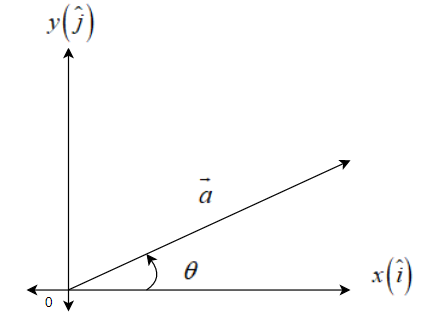Question
Question: Write all the unit vectors in XY- plane....
Write all the unit vectors in XY- plane.
Solution
For solving this question you should know about the unit vectors in planes. A unit vector in the XY- plane indicates that there is no Z-axis, we have to find the value of a=xi+yj and for that we will let a unit vector a and using the formula of dot product a.b=abcosθ we will find the value of X and Y.
Complete step-by-step solution:
According to our question it is asked to write all the unit vectors in the XY- plane. Let the unit vector be a, we know that a=xi+yj+zk, where x-axis is i, y-axis is j and z-axis isk. Since the vector is in XY-plane, that means there is no z-coordinate (z = 0). Then,
a=xi+yj+0k⇒a=xi+yj
The unit vector in the direction of x-axis is i and y-axis is j.

Angle with x-axis:
Since a makes an angle of θ with x-axis, so angle between a and i is θ.
We know that: a.b=abcosθ
So, putting a=a,b=i,θ=θ
a.i=aicosθ
As a is a unit vector, a=1 and i is a unit vector, i=1. So,
a.i=1×1×cosθ⇒a.i=cosθ⇒(xi+yj+0k).i=cosθ⇒(xi+yj+0k).(1i+0j+0k)=cosθ⇒x.1+y.0+0.0=cosθ⇒x=cosθ

Angle with y-axis:
Since a makes an angle of (90∘−θ) with y-axis, so angle between a and j is (90∘−θ).
We know that: a.b=abcosθ
So, putting a=a,b=j,θ=(90∘−θ)
a.j=ajcos(90∘−θ)⇒a.j=1×1×cos(90∘−θ)⇒a.j=cos(90∘−θ)⇒a.j=sinθ⇒(xi+yj+0k).j=sinθ⇒(xi+yj+0k).(0i+1j+0k)=sinθ⇒x.0+y.1+0.0=sinθ⇒y=sinθ
Thus,
a=xi+yj⇒a=cosθi+sinθj
This value will be true in all quadrants. So, 0≤θ≤2π.
Therefore a=cosθi+sinθj; for 0≤θ≤2π.
Note: While solving this type of questions you should be careful of the angles from the x-axis and y-axis and always, we have to make a unit vector. And this will be mandatory to be in the XY-plane. And if it is in the XY-plane, then the rest Z-plane coordinate must be always zero.
